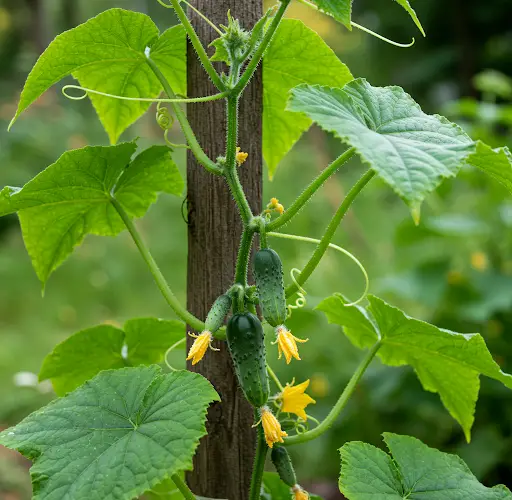Boost Your Cucumber Harvest Naturally with This Simple Yeast Fertilizer
Cucumbers are a popular choice in many home gardens thanks to their refreshing taste, versatility in the kitchen, and relatively quick growth. However, to ensure a bountiful and high-quality harvest, cucumbers need more than just sunlight and water—they also require a steady supply of nutrients throughout the growing season. Without proper nourishment, cucumber plants may grow weak, produce fewer fruits, or become more vulnerable to pests and diseases.
While there are many synthetic fertilizers available, natural options are often safer for the environment, better for soil health, and more cost-effective. One particularly effective and easy-to-make natural fertilizer involves a common household ingredient: dry yeast. This simple mixture can do wonders for the health and productivity of your cucumber plants.
Why Do Cucumbers Need Fertilizer?
Cucumber plants are nutrient-hungry. They grow quickly, produce abundant foliage, and develop numerous flowers and fruits in a short amount of time. This intense growth cycle means they require a consistent supply of essential nutrients—particularly nitrogen, potassium, and phosphorus—to thrive.
Over time, the soil in your garden can become depleted of these nutrients, especially if you grow cucumbers or other heavy feeders in the same spot year after year. Without replenishment, the plants may suffer from nutrient deficiencies, leading to yellowing leaves, stunted growth, fewer blossoms, and poor fruit quality.
That’s where the use of natural fertilizers comes in. They help restore the soil’s fertility, promote healthy plant development, and support beneficial microorganisms that contribute to long-term soil health.
The Power of Yeast in the Garden
Dry yeast isn’t just for baking—it’s a surprisingly powerful ally in the garden. When used as a fertilizer, yeast contributes in several important ways:
-
Enhances Soil Microbial Activity: Yeast introduces beneficial microorganisms to the soil. These microbes help break down organic matter, releasing nutrients in forms that plants can absorb more easily.
-
Stimulates Root Development: The active compounds in yeast encourage robust root growth, helping plants anchor more effectively and absorb nutrients more efficiently.
-
Boosts Plant Immunity: Yeast can support plants’ natural defenses, making them more resilient against fungal diseases and certain pests.
-
Encourages Fruit Production: With better nutrient uptake and root strength, cucumber plants are better equipped to produce more flowers and, ultimately, more fruit.
How to Make Yeast Fertilizer for Cucumbers
Creating this natural fertilizer is quick and easy. You only need three ingredients, and you probably already have them at home.
Ingredients:
-
10 grams of dry yeast
-
1 tablespoon of sugar
-
5 liters of warm water
Instructions:
-
In a bowl, combine the dry yeast with the sugar.
-
Pour in a small amount of lukewarm water—just enough to dissolve the mixture—and let it sit for 10 to 15 minutes. This resting period activates the yeast.
-
After the yeast becomes foamy or bubbly, pour the mixture into a container with the remaining warm water and stir thoroughly.
-
Your natural fertilizer is ready to use!
How to Use the Yeast Fertilizer
This fertilizer should be applied to your cucumber plants every 10 to 14 days. For best results, water the base of each plant with the mixture either early in the morning or in the evening when temperatures are cooler and the sun is not too intense. This timing helps minimize evaporation and allows the plants to absorb nutrients more effectively.
While this fertilizer is especially beneficial for cucumbers, it can also be used with other garden vegetables such as tomatoes, peppers, and zucchini.
Additional Tips for Healthy Cucumbers
-
Mulch generously: Apply organic mulch such as straw, compost, or dried leaves around the base of the plants to retain moisture and suppress weeds.
-
Keep soil consistently moist: Cucumbers thrive in evenly moist soil. Water deeply and regularly, especially during hot weather.
-
Provide support: Use trellises or cages to keep the plants upright. This improves air circulation, reduces disease risk, and makes harvesting easier.
-
Rotate crops: Avoid planting cucumbers in the same spot year after year. Rotating crops helps prevent soil-borne diseases and balances nutrient levels.
A Natural Solution That Delivers Results
Feeding your cucumbers with a homemade yeast-based fertilizer is an effective way to encourage strong growth, vibrant leaves, and abundant fruit. It’s a sustainable and affordable approach that enhances not just the plant, but also the overall health of your garden soil.
By integrating this simple yet powerful fertilizer into your gardening routine, you can enjoy healthier cucumber plants and a more productive harvest—without the need for harsh chemicals or expensive store-bought products.
Give this method a try and watch your cucumbers thrive naturally all season long!



